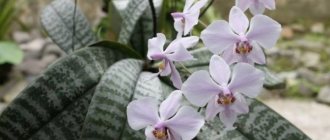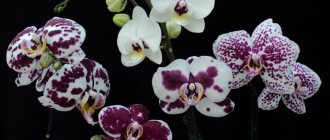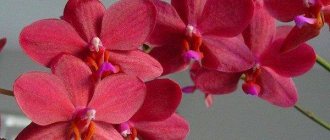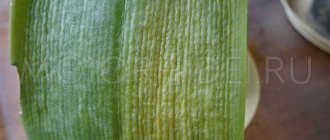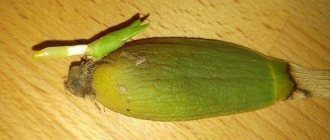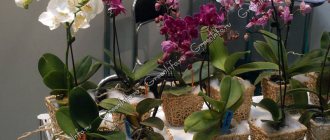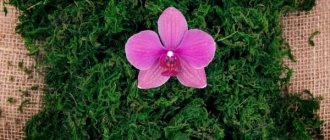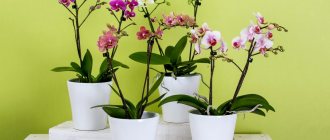Landing Features
Pot or planter?
This type of orchid can be grown in special orchid pots (clear or perforated), orchid planters on blocks . The method of planting phalaenopsis depends on the conditions and preferences of the grower.
If the air humidity is high, the plant will grow well on a block or in a basket. In such conditions, a phalaenopsis basket is an ideal option due to good ventilation and quick drying.
When indoor humidity is low, it is better to give preference to planting in a pot to reduce the frequency of watering. We will tell you how to care for an orchid in a pot below. Also, some gardeners are experimenting with growing orchids in a closed system.
Options for containers for phalaenopsis.
Read more about growing in a closed system here.
Transfer
Phalaenopsis transplantation is carried out after purchase, and also as needed when:
- the substrate has lost its structure, decomposed or become highly salted;
- the plant has outgrown the pot;
- the soil is infected with pests or diseases;
- Phalaenopsis needs resuscitation.
Read more about transplantation here.
Priming
The substrate for planting must be sufficiently moisture-absorbing, but at the same time breathable. When choosing a substrate for transplantation, you also need to take into account the conditions of detention. The easiest way is to buy ready-made soil for orchids, but this option is not always the best. After all, it is extremely difficult to change a universal substrate to suit the conditions of a specific room:
- Thus, with high air humidity and soft water for irrigation, only pine bark can be used as a substrate;
- if the air in the room is dry , then it is better to add components to the bark that will retain moisture in the pot, for example, sphagnum moss and coconut chips;
- if the water contains hardness salts , it is recommended to add charcoal to the substrate, which will absorb excess salts.
Composition of soil for phalaenopsis.
You can learn more about planting from this article.
Flower planting technology
Planting an orchid is not difficult. However, it is necessary to choose the right pot and soil. How the flower will feel and whether it will be able to develop normally depends on this. It is better to use a plastic pot. It must be transparent. The root system should also receive sunlight. Despite the fact that many phalaenopsis do not need soil, it is better to use it. This will ensure the plant's stability.
There are certain requirements for the selection of soil. It should consist of:
- large bark;
- sphagnum moss;
- coconut fiber;
- coal
Reference. Some florists themselves make the necessary mixture, however, in this case there is a risk that it contains pest eggs. To avoid this, you should buy soil in specialized stores. It has already been treated against possible pests, and is also enriched with nutrients that are so necessary for the plant at any stage of its life. That is, after planting there will be no need to apply mineral fertilizers.
Here's how to plant a flower:
- first you need to disinfect the pot;
- then place a drainage layer in it;
- then you need to pour the prepared mixture into it;
- plant an orchid;
- You also need to sprinkle the flower with a little earth on top.
Important. Do not apply fertilizer right away. The culture needs to be placed in a dark room for a couple of days so that it can acclimatize. Then it is placed in the place where it will grow. From this moment you can begin to introduce fertilizing.
Caring for a phalaenopsis orchid at home
Let's look at the main points on how to care for flowers at home.
Conditions of detention
Housing conditions include: temperature, humidity and light. The optimal balance of these factors will help maintain a healthy plant.
Phalaenopsis naturally grows in tropical rainforests, which means it does not have a dormant period and prefers warm conditions throughout the year:
- the optimal temperature is considered to be 18-25°C;
- Plants do not tolerate temperatures below 10°C and above 30°C, especially for a long time;
- The temperature for an orchid in winter can be reduced by several degrees, especially if there is no additional lighting.
High air humidity is not necessary for phalaenopsis, because most of the hybrids that are sold in stores are bred and adapted specifically for indoor keeping.
Too low humidity can be compensated by more frequent watering and periodic spraying , but with high humidity you will have to provide good ventilation to avoid rotting of the roots and leaves of the plant.
Read more about the need to spray phalaenopsis in this article.
Carefully! When spraying phalaenopsis, it is important to ensure that wet leaves are not exposed to direct sunlight. Drops of water in bright light act like lenses and cause sunburn. It is better to completely abandon this procedure unless absolutely necessary.
Phalaenopsis is shade-tolerant. Bright light, especially direct sunlight, is not only unnecessary, but also detrimental to the plant. Several hours in the scorching sun can lead to loss of decorativeness. Moderate lighting is considered optimal , but it will grow and bloom even on a northern window and under completely artificial lighting.
You will get more information about growing phalaenopsis at home from this article.
Watering and fertilizing
This point requires the most attention, because there are nuances and rules for watering orchids . Contrary to the prevailing stereotype that orchids need frequent watering, the risk of dying from flooding is tens of times higher than from lack of moisture.
Phalaenopsis, thanks to the moisture stored in the leaves, can withstand several weeks without watering , while several weeks with “wet feet” will certainly lead to rotting of the roots.
Photo of wet and dry roots.
Advice! If you are in doubt whether or not to water the orchid, wait 1-2 days and only then water.
The substrate must always dry out between waterings , and the water should not remain in the tray for more than 15 minutes. To correctly assess the condition of the substrate, you need to look at the roots and the pot. If perspiration appears on the pot, then the substrate has not yet dried. Wet roots are rich green, while dry roots are silver.
When watering, do not simply pour water from a watering can into a tray or pot. It is better to completely immerse the pot in a basin of warm water for 10-15 minutes so that the substrate absorbs enough moisture. Then let the excess water drain and only then return the plant to its permanent place.
The plant responds well to watering with a warm shower , which imitates natural conditions as much as possible. However, after such a bath, you need to remove the water from the outlet so as not to cause rotting of the growing point.
Read this article about how often to water phalaenopsis.
Fertilizers can be added 2-3 times a month to water for irrigation. It is advisable to use special fertilizers for orchids and dilute them 2 times stronger than indicated on the package. In some cases, foliar foliar feeding can be used.
Read more about fertilizing here.
Trimming
Traditional pruning methods for phalaenopsis are unacceptable and not necessary. The orchid grows very slowly, forming no more than 4-5 new leaves per year, and the stem grows in length by 1-3 cm. It is also not recommended to trim old and dying leaves. As a rule, the plant takes all the nutrients from them and the leaf eventually falls off on its own.
The need for complete or partial pruning of leaves arises only if the leaf is damaged by any disease or broken. In this case, the entire damaged area is cut off to healthy tissue, and the cut is treated with crushed coal.
During replanting, it may be necessary to trim the roots. However, only dry, rotten or broken roots are removed. As in the case of leaves, everything is trimmed down to healthy tissue, and the cut is processed.
After the phalaenopsis has faded, it is recommended to trim the peduncle a little. Only the dried top is removed until the first healthy bud.
Trimming diagram.
Advice! Do not completely cut out the green, undried peduncle. From the remaining buds, lateral peduncles with new buds can develop, and flowering will occur much earlier than if the peduncle is completely removed to the level of the leaves.
Rejuvenation
Old plants that have lost leaves at the bottom of the trunk can be rejuvenated. To do this, you need to grow roots on the exposed part.
Root formation can be stimulated by periodically spraying the substrate. If this is inconvenient, the trunk can be wrapped in sphagnum.
When the buds of young roots appear, the lower part of the plant with old roots can be cut off and used for propagation.
Read more about how to rejuvenate a plant here.
Maintenance and care
This is the most important part, since a lot depends on proper care of the plant. It is worth considering what needs to be done so that it feels good and can bloom profusely for a long time.
It is very important to water correctly. The orchid loves moisture, but if there is a large amount of it, the roots quickly begin to rot. Here is the watering algorithm:
- It is necessary to water once every 7-10 days if the plant does not bloom.
- During the flowering period, water every 10-12 days.
- If it is hot outside, watering is done every 2-4 days.
- You can determine whether it is necessary to water by looking at the top layer of soil: if it is dry, then it should be moistened.
- Spraying is required periodically. However, water should not get into the rosettes of the leaves, as this can cause rotting.
Reference. It is impossible for moisture to get into the rosette of the sheet. It must be removed immediately. Otherwise, the flower will begin to rot. You also need to remove all the water that will be in the pan 30 minutes after watering.
There are also temperature requirements. So, the air temperature should not be higher than 27 degrees and lower than 22 degrees. The exception is night. Then a decrease to +18 degrees is allowed. The orchid loves moist air, so many florists install a humidifier in the room where it stands. You can also place a container of water nearby. It will be much cheaper, but the result will be the same. The optimal humidity level is 80% - 90%.
It is recommended to introduce fertilizing. Here are some nuances that are worth knowing:
- it is necessary to purchase specialized mineral fertilizers for orchids;
- minerals are diluted according to the instructions, but the dosage is slightly less;
- Next, you need to introduce complementary foods;
- observe the behavior of the plant for 2-3 days;
- Continue complementary feeding according to instructions.
These are the basic rules for caring for a flower. After flowering, you need to remove dried buds, as pathogens can form in them.
Reproduction
It is worth moving to this point only if a “common language” has been found with the plant, i.e. the phalaenopsis is actively growing new leaves and blooming regularly, and the number of flowers and peduncles is increasing each time.
At home, phalaenopsis is most often propagated by vegetative methods:
- separation of root daughter rosettes;
- children formed from the buds of the peduncle;
- dividing an adult plant;
- cuttings of peduncles.
Before wondering how to plant phalaenopsis, you need to examine the plant and understand whether it has daughter rosettes, children or other additional growth points. And only then choose the appropriate method of reproduction.
Baby on a peduncle.
Read more about reproduction methods here.
From this article you will learn how to properly plant phalaenopsis.
Seeds
Seed propagation outside special laboratories is problematic and does not always guarantee an exact copy of the mother plant. The offspring will be numerous and varied.
Phalaenopsis seeds are dusty and cannot germinate on their own without a special medium or symbiotic fungi.
You can get all the information about pollination of phalaenopsis from this article. In this article you can learn how to get phalaenopsis seeds.
Read more information about seed propagation here.
Secrets of flowering
As a rule, there are no special problems with the flowering of healthy plants , but sometimes it happens that large and well-growing specimens do not form flower stalks for several years. The reason for this behavior of the plant may be:
- too regular and careful care;
- the substrate is not allowed to dry out between waterings;
- excessive amounts of fertilizer;
- constant temperature day and night.
Despite the relative stability of natural conditions, even in the tropics there is a slight difference in day and night temperatures, and the rainy season is replaced by a relatively dry period. It is during the dry period that plants bloom.
Therefore, in order to stimulate flowering, sometimes it is enough to simply forget about the flower for a while, creating extreme conditions for it that will stimulate flowering.
Interesting! Sometimes you can stimulate the formation of flower stalks with the help of darkness. To do this, the plants are placed in a dark place for 3-7 days or a bag of thick dark material is put on it.
Mistakes when leaving, how to avoid them
Phalaenopsis can be called one of the hardiest orchids, which can forgive beginners almost all care mistakes. Oddly enough, the likelihood of “loving a flower to death” is much higher than losing it if the conditions of maintenance are not met.
Where is the best place to place it?
It is important to immediately find a permanent place where it is better to place the orchid, do not twist or move it several times a week or even a day. The plant will feel good even on a north window. The main thing is to avoid direct sunlight and drafts.
Phalaenopsis bloom beautifully even on a north-facing window.
How to water and fertilize?
When watering, do not use cold or very hard water. Water should not linger in the pot or tray, and the substrate should dry out between waterings. Do not use fertilizers with a high nitrogen content, and dilute fertilizers for orchids more than recommended.
You can learn more about the rules and methods of watering here.
Black orchid - myth or reality
There is an opinion that the botanist-naturalist J. Cranleith stole this outlandish beauty from one of the tribes in South America. According to legend, the scientist’s recklessness gave the world black color in the palette of orchid varieties.
Another version of the origin of this unusual beauty is the selection of different types of phalaenopsis. Due to the high level of costs required to create this species, it is quite rare.
More efficient scientists achieve “black” results through injections. But still, for the most part, flower growers are inclined to the hybrid version of the appearance of the black orchid flower. This species is based on Phalaenopsis.
Reanimation
Maintenance errors can most often lead to loss of roots, lack of leaf turgor, and premature falling of flowers and buds. Such plants will need resuscitation.
If leaf turgor is lost due to untimely watering, periodic bathing in well-warm water and increasing air humidity can save the situation.
In case of partial or complete loss of roots, it is necessary to replace the old substrate, temporarily stop watering the pot and replace it by spraying the surface of the substrate. If there are no roots at all, you can place the rosette in a bowl with damp moss.
Such flowers will have to be fertilized and watered leaf by leaf.
You can grow roots on damp moss.
You will learn more about the resuscitation of phalaenopsis from this article. In this article you will find complete information on how to grow plant roots.
Caring for sick plants
Resuscitation also includes caring for sick flowers. However, if we are talking about a plant being damaged by diseases and pests, then it is necessary to treat it with special preparations and keep such a specimen separately from other plants until complete recovery.
It is also recommended to keep phalaenopsis that were recently purchased , since in a store with a large concentration of plants there is a high probability of infection with diseases and pests.
Read this article about how to properly care for plants after purchase.
Questions about content
Next, we will answer some of the most common questions about how to care for phalaenopsis (phalaenopsis).
How do you know when it's time to water?
If an orchid grows in a transparent hill, then you should pay attention to the color of the roots.
Beginners should place a wooden skewer or long sliver of wood in the center of the pot when replanting. Before watering, you need to pull it out and look at its condition.
If the skewer is wet, then watering should be postponed.
How to care for a painted plant?
Caring for painted phalaenopsis is not particularly different , but the viability of such plants is much lower due to the influence of the dye. When purchasing, it is better to choose a plant with a natural color, because over time, blue or dark blue flowers will inevitably turn white.
Do you need lighting in winter?
Phalaenopsis can easily survive the winter without lighting, but poor lighting can still stunt growth and delay flowering. To avoid this, you can use special phytolamps to increase the length of daylight hours.
Orchid lighting.
How to wake up phalaenopsis?
Sometimes the plant freezes and stops growing. Often this phenomenon occurs due to unfavorable conditions, for example in winter with a lack of light and lower temperatures . When conditions improve, phalaenopsis begins to form new leaves again.
Such periods of rest are quite normal. The flower cannot grow continuously and requires short breaks to gain strength to grow new roots and leaves.
What should be the care during flowering?
Care during flowering is not much different from normal daily care.
However, you should try to move the orchid less and rotate it around its axis while the flowers are blooming, and also avoid drafts and moisture getting on the flowers.
You can prolong flowering a little with the help of special fertilizers.
Do you need LED phytolamps?
Special lamps can be used when there is a severe lack of natural light. If the light mode is normal, then there is no need for lamps. However, in winter, when light levels are low, phytolamps will help stimulate flowering and not stop growth.
Varieties of black orchid
In nature, there is no pure black orchid color. A high level of selection has brought the shades of other dark colors closer to black.
Important! The burgundy color of the orchid, artificially darkened, gives a color close to black.
Kinds:
- The darkest, most elegant, graceful type of black orchid is Maxillaria Schunceana.
- The wine shades of the large flowers are Cumbidium Kiwi Midnight.
- The petals are the wings of a dark burgundy butterfly - Phalaenopsis Black Butterfly.
- Fredclarkeara After DARK Black Pearl - The blue color is so strong that it is called black.
- A large "black" orchid with dragon-like flowers with dark stripes giving the plant a dark color is Dracula roezlii.
- Paphiophtdilum Nachtwatch - the rich dark brown and burgundy shade of the flowers is its distinctive feature.
- Orchid Tacca - “Bat” and “Black Lily” are called by true connoisseurs of such beauty. The black Phalaenopsis orchid and the Tacca orchid are representatives of 2 different families. Thus, this flower has only an indirect connection with orchids.
